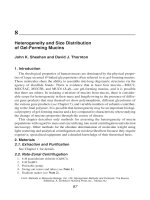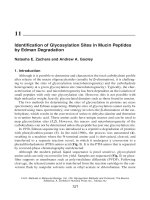Glycoprotein methods protocols - biotechnology 048-9-191-209.pdf
Bạn đang xem bản rút gọn của tài liệu. Xem và tải ngay bản đầy đủ của tài liệu tại đây (272.98 KB, 19 trang )
Analysis of Mucin-Type
O
-Linked Oligosaccharides 191
191
16
Structural Analysis
of Mucin-Type
O
-Linked Oligosaccharides
André Klein, Gérard Strecker, Geneviève Lamblin,
and Philippe Roussel
1. Introduction
The carbohydrate moiety of mucin is characterized by the presence of oligosaccha-
rides linked to the peptide backbone by an O-glycosidic linkage between an N-
acetylgalactosamine residue and a hydroxylated amino acid (serine or threonine).
These linkages are alkali labile and the carbohydrate chains can be released as oli-
gosaccharide-alditols by a β-elimination, with NaOH in the presence of NaBH
4
. The
structures of carbohydrate chains found in mucins can be as simple as the disaccharide
NeuAc α2→6GalNAc in ovine submaxillary mucin and as complex as the ones found
in human respiratory or salivary mucins, in which several hundred different carbohy-
drate chains exist (1,2). This diversity is generated (1) by the different monosaccha-
rides constituting the glycans, generally fucose, galactose, N-acetylgalactosamine,
N-acetylglucosamine, and N-acetyl neuraminic acid, but also other monosaccharides
such as ketodesoxynonulosonic acid or N-glycolylneuraminic acid, and, finally the
occurance of sulfation of galactose and N-acetylglucosamine (3,4); and (2) by the dif-
ference in length, in branching, and by the occurrence of all the different possible
linkages between the constituting monosaccharides. The diversity of mucin-type oli-
gosaccharides can be extreme. For example, 88 oligosaccharides have been isolated
from the respiratory mucins of a single individual (5–10) and more than 150 have been
isolated from the jelly coat from eggs of different species of amphibians (11–15).
This chapter gives an overall idea of the strategy of elucidation of primary structure
of glycans, the most current nuclear magnetic resonance (NMR) techniques used in
structure determination, and some of the mass spectrometry (MS) techniques avail-
able for the glycobiologist.
1.1. Strategy
The amount of pure oligosaccharide (or of a mixture of two compounds, or three at
the most) and the facilities that are available in the laboratory environment will define
From:
Methods in Molecular Biology, Vol. 125: Glycoprotein Methods and Protocols: The Mucins
Edited by: A. Corfield © Humana Press Inc., Totowa, NJ
192 Klein et al.
the strategy. Two types of techniques are used: a destructive technique, MS and a
nondestructive technique, NMR. Figure 1 summarizes the sequence of techniques.
When the amount of oligosaccharide permits the use of NMR first, especially if two-
dimentional (2D) NMR can be performed, MS is only used to confirm the structure if
it is a novel one; in most cases, it is not needed. MS is quite useful when there is not
enough material for NMR or when the mixture studied is too complex.
1.2. Nuclear Magnetic Resonance
NMR spectroscopy constitutes the most suitable method for the structure determi-
nation of carbohydrate chains. This method was introduced in the 1970s and rapidly
received a large application for analyzing the sequence of N-acetyllactosamine- and
oligomannosidic-type glycans.
Originally, and before the development of 2D NMR spectroscopy, the method was
limited to one-dimentional
1
H-NMR spectroscopy, which has led to the concept of
“structural-reporter groups.” In these conditions, depending on the field of spectrom-
eter (600–300 MHz), 20–100 nmol will constitute a sufficient amount of material to
apply a “finger-print” method. Nevertheless, the method is restricted to compounds
which are members of a series of closely related sequences, as it is happily the case for
most of O-glycans.
When the material is available in the range of 0.1–5 µmol, the de novo structural
elucidation of the sequences can be easily deduced from the compilation of data fur-
nished by various homo and heteronuclear 2D NMR methods.
1.3. Mass Spectrometry
MS has become an indispensable tool for the determination of carbohydrate struc-
tures. The information provided by this methodology ranges from the accurate mo-
lecular weight determination to the complete primary structure with a sensitivity such
that only picomoles of oligosaccharides are necessary. These remarkable advances
have been made possible with the appearence of novel methods of ionization such as
fast atom bombardment ionization (FAB), electrospray ionization (ESI), and matrix-
assisted laser desorption ionization (MALDI).
2. Methods
2.1. Nuclear Magetic Resonance
2.1.1. Proton-NMR as a Fingerprinting Method
The proton-NMR method was developed by Vliegenthart and colleagues during the
1970s and essentially applied to the structure determination of N-glycans of the N-
acetyllactosamine and oligomannoside type (16). More recently, a similar procedure
was summarized for the primary structural analysis of oligosaccharide-alditol released
from mucin-type O-glycosylproteins (17). This method is based on the recognition of
some atom resonances that constitute probes for representative structural elements.
These structural-reporter groups resonate outside the bulk constituted by the
nonanomeric protons.
1
H-NMR structural-reporter group signals correspond to the
following atom resonances: anomeric protons; GalNAc-ol H-2, H-4, H-5 and H-6'
Fig. 1
Analysis of Mucin-Type
O
-Linked Oligosaccharides 193
atoms; Gal H-3 and H-4 atoms; Fuc H-5 and H-6 atoms; NeuAc H-3ax and H-3eq
atoms; and CH
3
of the acetamido groups.
The first step of spectrum analysis consists of the identification of the core region
(Table 1), based on the characteristic chemical shifts of the H-2 and H-5 atom reso-
nances of the GalNAc-ol unit. Moreover, the quadruplet of the H-6' signal of GalNAc-
ol is upfield shifted out of the bulk at δ ~ 3.50 ppm in the case of an O-6 substitution
with sialic acid. The presence of α-2,3- or α-2,6-linked sialic acid is clearly shown by
the respective chemical shift of the H-3ax and H-3eq signals of the monosaccharides.
The H-3ax and H-3eq resonances of the α-2,3-linked NeuAc are systematically
downfield shifted, compared to the corresponding signals of α-2,6-linked NeuAc.
The attachment of NeuAc at O-3 of a Gal unit causes downfield shifts of the Gal
structural-reporter groups, as clearly indicated in Fig. 2, in which the NMR spectra of
asialo and sialo glycans are compared (compounds N-1 and A-1).
Fig. 1. Strategy of elucidation of oligosaccharide primary structure.
194Klein et al.
194
Table 1
Chemical Shifts of GalNAc-ol Residues Characteristic of the Nature of Oligosaccharide-Alditol Cores
Gal(β1–3)GalNAc-ol GlcNAc(β1–3)GalNAc-ol Gal(β1–3)[GlcNAc(β1–6)]GalNAc-ol NeuAc(α2–6)GalNAc-ol
H-2 4.393 4.286 4.391 4.246
H-3 4.063 3.995 4.069 3.846
H-4 3.506 3.546 3.468 3.411
H-5 4.193 4.141 4.277 4.020
H-6' 3.628 ND ND 3.532
Gal(β1–3)[NeuAc(α2–6)]GalNAc-ol GlcNAc(β1–3)[NeuAc(α2–6)]GalNAc-ol GlcNAc(β1–6)GalNAc-ol
H-2 4.378 4.260 4.242
H-3 4.055 3.984 3.841
H-4 3.534 ND 3.379
H-5 4.244 4.185 4.021
H-6' 3.486 3.490 3.933
Analysis of Mucin-Type
O
-Linked Oligosaccharides 195
Fig. 2.
1
H-NMR spectra of three oligosaccharide-alditols. N-1, basic structure devoid of
fucose and sialic acid residue; N-2, downfield shift of Gal
3
H-1 owing to the α-1,2 fucose; A-
1, downfield shift of Gal
3
H-1 and H-3 owing to the α-2,3 sialylation. The first superscript after
the abbreviated name of a monosaccharide residue indicates to which position of the adjacent
monosaccharide it is glycosidically linked (e.g., Gal
4
in the case of Galβ1→4 GlcNAcβ1→).
Fucose units can be easily identified according to the presence of methyl reso-
nances at ~ 1.2 ppm. The α-1,2 (H), α-1,3 (Le
x
), and α-1,4 (Le
a
) linkages are deduced
from the position of H-1, H-5, and H-6 resonances. For instance, the Le
x
and Le
a
epitopes can be characterized on the basis of their H-1 (Le
x
: δ ~ 5.13–5.14; Le
a
: δ ~
5.02–5.05), and H5 (Le
x
: δ ~ 4.80–4.85; Le
a
: δ ~ 4.86–4.88) resonances, whereas the
196 Klein et al.
H-5 signal of α-1,2-linked Fuc is observed at δ ~ 4.25–4.34 ppm. These NMR data
imply, respectively, the presence of type 2 (Galβ1-4GlcNAc) and type 1 (Galβ1-
3GlcNAc) backbone structures.
The analysis of compounds with a higher complexity in backbone sequence cannot
be developed in some pages, and such analyses often call for additional chemical (me-
thylation analysis) or physical (MS, nuclear Overhauser effect [NOE] measurements)
operations.
Figures 3 and 4 give examples of complex backbones. Compounds were analyzed
by methylation analysis, which precises the location of the hydroxyl groups impli-
cated in the glycosidic linkages. The comparison of the spectra N-4B, N-4A, N-6B,
and N-8 clearly indicates the presence of the same sequence Gal(β1-4)GlcNAc(β1-6)
GalNAc-ol, as shown by the NMR parameters of Gal
4
and GlcNAc
6
. This comparison
between N-1, A-1, and A-3 (Fig. 2) also gives the chemical shift of the sialylated and
terminal Gal unit O-3 linked to GalNAc-ol. Consequently, the upper branch of com-
pound A-3 is composed of two Gal and two GlcNAc units. Other models (not shown
here) also possess the sequences Gal(β1-3)GlcNAc(β1-3)Gal(β1-4)GlcNAc or
Gal(β1-4)GlcNAc(β1-3)Gal(β1-4)GlcNAc, with additional Fuc or NeuAc attached to
the terminal galactose units. Since the presence of these peripheral monosaccharides
affects essentially the chemical shifts of the terminal galactose, the anomeric protons
can be assigned step-by-step.
The compilation of 168 NMR spectra which are included in the review of Kamerling
et al. (17) clearly shows that a spectrum is unique and can be used as an “identity
card.” This review presents the carbohydrate chains in a logical order and gives a
classification according to the nature of the core, the nature of the backbone, and the
peripherical monosaccharides. Actually, the nature of the backbone can be often di-
Fig. 2. Continued.
Analysis of Mucin-Type
O
-Linked Oligosaccharides 197
rectly deduced from the linkage of the fucose units, as discussed previously. When the
presence of these structural elements has been established, the number of possibilities
decreases deeply, and a survey of the corresponding class of oligosaccharide-alditols
furnishes rapidly the structure of the compound. Most of the O-glycans that constitute
the carbohydrate moiety of mucins isolated from human tissues have now been de-
scribed, but completely new structures can be isolated from other biological sources.
If a sufficient amount of material is available, de novo structural elucidation of glycan
sequences should be performed by 2D NMR spectroscopy.
Fig. 3.
1
H-NMR spectra of oligosaccharide-alditols with the common tetrasaccharide N-1
(see Fig. 2) variously substituted.









